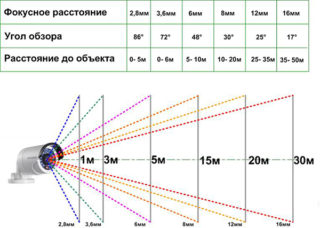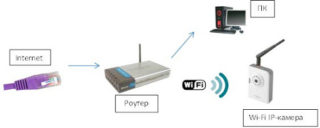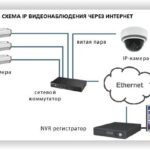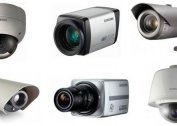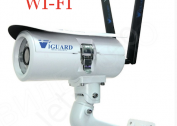One of the useful features of information technology is access to surveillance cameras over the Internet. Real-time recordings and broadcasts are viewed from different parts of the globe. You can watch what is happening from a device that connects to a WI-FI network. The camcorder combines a module for generating sound and a digital video stream, as well as a lens and a memory unit.
Necessary equipment for organizing a video surveillance system
The formation of a monitoring system at the facility is not a difficult task; the user with the minimum amount of information in the field of PC and related equipment successfully copes with it.
The digital recorder receives recordings from a tracking device, processes incoming signals from an analog camera and records them on an information carrier. The memory unit may be stationary, for example, a hard disk, or removable. A connection to the server or software interface is required to configure the IP camera for monitoring via the Internet.
In the first case, you must enter the browser and use a specific page. Manufacturers of registrars provide the client with instructions for downloading a browser extension to facilitate connection. The software interface involves working through software that goes on the hard drive when selling equipment.
The DVR, router, camera are connected via a local network via cables or wirelessly. The router organizes the local network if it is formed via WI-FI and is used to connect to the Internet. Programs and utilities provide remote viewing on a computer or TV.
Characteristics when choosing a camcorder
Analog cameras are directly connected to the screen of the receiving device and work with the video signal PAL and NTSC. Devices write information to a computer or DVR. Digital IP cameras convert information to digital format and transmit the picture to the cloud via wireless transmission over 4G, WI-FI, 3G networks. The user observes the situation, being far from the object on the screen of the phone, smartphone and other gadget.
When buying, pay attention to the quality of the lens, which is provided by the number of megapixels. The susceptibility of the matrix and the possibility of application in a wide range of dynamics depend on the number of points on the screen.
Characteristics that you need to pay attention to connect to a surveillance camera without problems:
- manual setting of parameters:
- video input and output for direct connection to a TV;
- type of battery (lithium-ion, nickel-cadmium);
- color or black and white.
The photosensitivity of the device plays a role, since monitoring is carried out around the clock. The infrared camera works in the dark. If this property is not in the specifications, an IR illuminator is purchased separately.
Ways to connect to a surveillance camera
The instructions provide information on the operation of the camera. The device operates without an injector through a network wire through PoE. Remote functions can only be accessed if you have a specific browser, for example, new Firefox or Chrome, other installations use an outdated version of IE. The broadcast format on the Internet also varies, some require VLC, others work with Flash Player or Java.
Connection is carried out in the following ways:
- WI-FI - broadcast wirelessly;
- Ethernet - uses a cable bus (twisted pair);
- PoE is a wired connection, but the power is supplied through individual cores of the pair, and not through other cables, an injector is required.
The camera is protected from hacking with a password and location address. Individual IP code is not a secret, because located at the standard address, and tracking modules respond easily to requests from search engines. CAPTCHA input is added to exclude automated intrusions. Modern tracking modules include self-tuning functions and easily interact with various services and programs.
Through the Internet
 IP address allocation is required to view cameras online via the Internet. An external individual code is also needed to interact with the Ivideon service. The internal address allows you to organize only work on the local network. To create a code, a port is used to transmit an external signal to the camcorder.
IP address allocation is required to view cameras online via the Internet. An external individual code is also needed to interact with the Ivideon service. The internal address allows you to organize only work on the local network. To create a code, a port is used to transmit an external signal to the camcorder.
Logging into the web interface of the router, for which the standard code 192.168.1.1 is written in the browser line. The user selects a username and password, in the factory settings, usually admin / admin. In an additional application, you need to go to the WAN sub-item to set up port forwarding. The "Virtual Server" section is selected in Russian or English letters.
Entering information:
- the name of the camera, for example, according to the premises of the house;
- port number, usually 808X, the last digit indicates the number of the video device;
- IP address similar to the specified parameter;
- the port that is registered in the camcorder settings, if not, then you need to write Internal port - 80;
- the protocol is set - TCP.
After that, you can connect to the camera from any gadget to view pictures.
The video device is configured to work through an Internet browser or using professional utilities, for example, Ivideon Server.
Via computer
 Used digital devices class CVI, TVI, AHD. The power supply is not sold with a camcorder, it is purchased separately. The 12V / 1A module is used for different types of cameras.
Used digital devices class CVI, TVI, AHD. The power supply is not sold with a camcorder, it is purchased separately. The 12V / 1A module is used for different types of cameras.
Used wires:
- coaxial cable transmits a quality signal to 100 meters without amplifiers;
- twisted pair combines 8 cores and reduces the cost of laying individual wires.
Analog models connect directly to a computer using a video capture card. Devices are placed in the system unit in a PCI-e or PCI slot with 4 to 16 contact inputs. For a laptop, this method is not suitable. Another method is to use a USB converter. An inexpensive module is combined with laptops and computers, but they are notable for their low reliability. Remotely recording can be seen if you connect the device to the Internet.
Modern IP cameras are designed to connect video surveillance to the Internet, but you can make a wired connection through the DVR and directly to the computer. Coaxial cable is placed at a distance of up to 100 m. If you need to transfer information further, twisted pair with amplifying transmitters are used.
Via tv
 Such a connection to cameras means only surveillance online without recording and adjusting from a distance. The option is applied if the monitor is equipped with an input contact for a composite signal. If there is no connector, a converter with a resolution of 740 x 576 BNC-VGA is purchased. If the camera has a high quality lens, it will deteriorate because a similar characteristic of the conductor corresponds to a resolution of 420 TVL.
Such a connection to cameras means only surveillance online without recording and adjusting from a distance. The option is applied if the monitor is equipped with an input contact for a composite signal. If there is no connector, a converter with a resolution of 740 x 576 BNC-VGA is purchased. If the camera has a high quality lens, it will deteriorate because a similar characteristic of the conductor corresponds to a resolution of 420 TVL.
The video signal is fed to the central pin, and the screen is connected to an external one. For analog devices with wire outputs, an adapter is made. On the one hand, BNC is turned on, and on the other, a tulip connector is placed. The connection is made with a coaxial cable (resistance 75 Ohm), the power supply is connected.
To view the video mode is selected:
- “SOURCE” key on the TV or on the remote control;
- on the on-screen menu, go to the sub-item “composite” or “AV”.
If the camcorder is equipped with four outputs, most often there are two pairs of wires. Yellow conducts a signal, while red conducts power. The rest are combined and work in a common mode. In order not to be mistaken, you need to study the instructions, where there are instructions on this issue.
Configure remote access to video surveillance
You can arrange work using a cloud server, mobile Internet, through a computer. The first method requires a minimum of effort. The subscriber part of the program from the proposed service list is placed on the control device. Setup is done according to the instructions offered with the software. This method works with mobile and cable Internet.
The option of adjusting via a WI-FI router and direct access to the camcorder is gaining popularity. The second method is more mobile, but is carried out in the presence of special types of cameras and appropriate computer programs.
More often, video surveillance devices are equipped with software, where there is a detailed instruction for setting operating parameters. The process consists of setting up a LAN, connecting the server to the Internet, connecting and installing the camera. The program independently finds the camcorder and determines its MAC and IP address. The common programs are Line, Axxon Next, and Ivideon, which differ in the number of simultaneously serving video devices.

